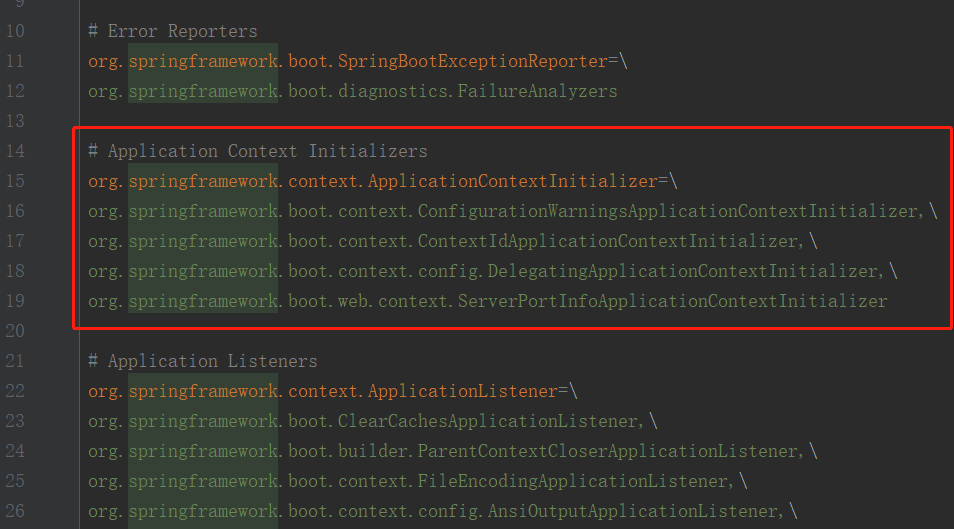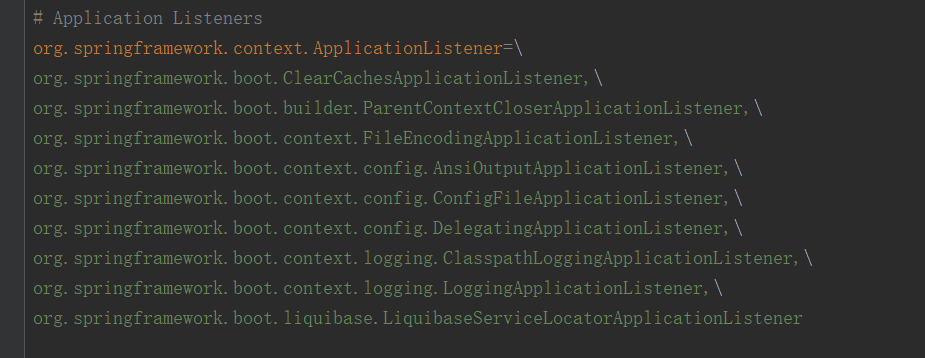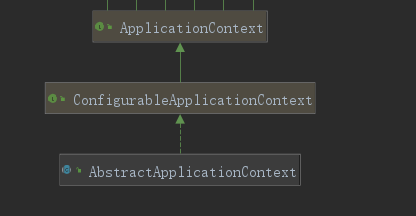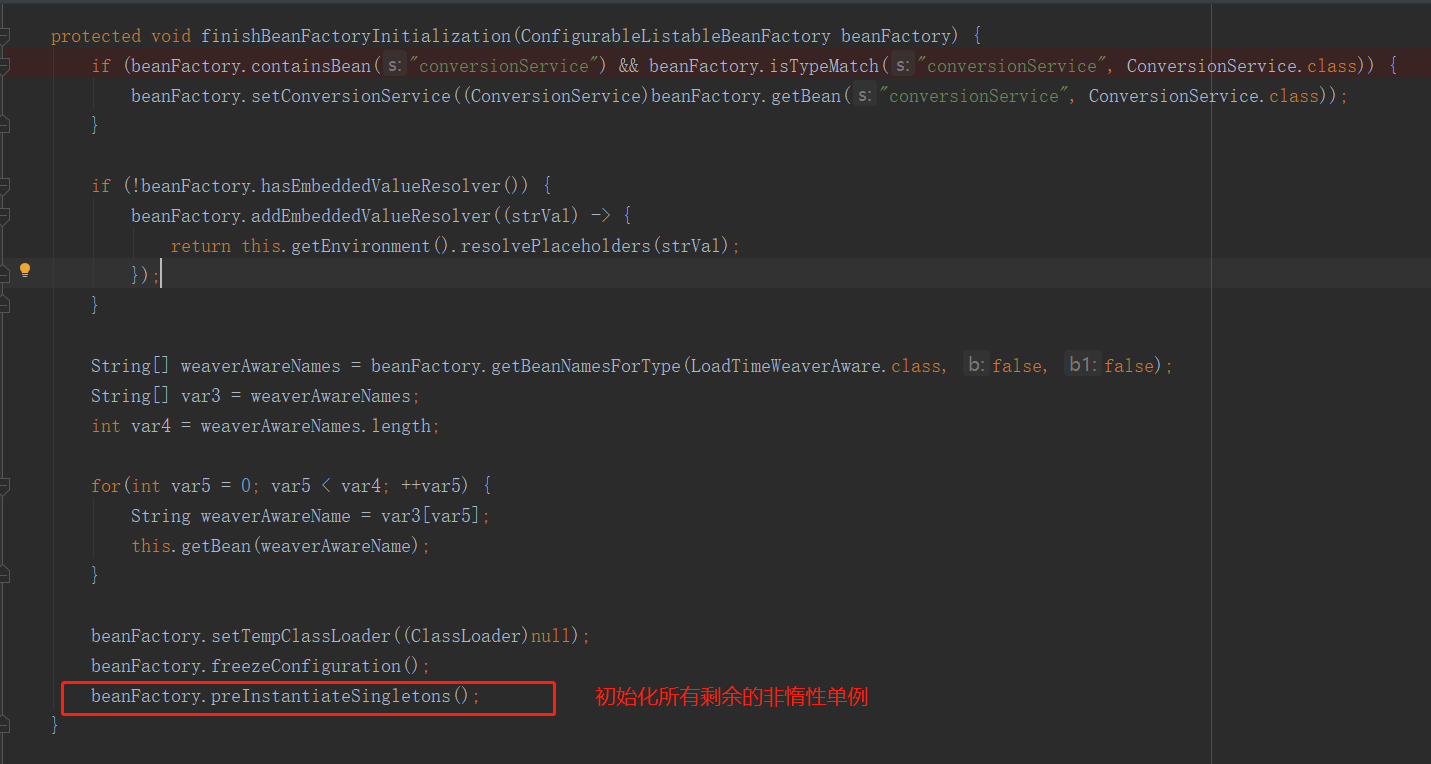SpringBoot 2.0.3 源码解析
前言
用SpringBoot也有很长一段时间了,一直是底层使用者,没有研究过其到底是怎么运行的,借此机会今天试着将源码读一下,在此记录。。。我这里使用的SpringBoot 版本是 2.0.3.RELEASE
源码解析
SpringApplication 的初始化
1.首先一个完整的SpringBoot项目一定会有个启动类,这里就是我们整个程序的入口;
@SpringBootApplication
public class TeachercommunitystudioApplication extends SpringBootServletInitializer{ public static void main(String[] args) {
SpringApplication.run(TeachercommunitystudioApplication.class, args);
}
}
2.只有一行代码,调用了 SpringApplication的静态 run()方法,
//调用重载run方法
public static ConfigurableApplicationContext run(Class<?> primarySource, String... args) {
return run(new Class[]{primarySource}, args);
}
//参数为Class<?>数组 1.+版本这里是Object
public static ConfigurableApplicationContext run(Class<?>[] primarySources, String[] args) {
return (new SpringApplication(primarySources)).run(args);
}
3.在run()方法中调用构造函数创建SrpingApplicatin的对象,入参其实就是启动类的class对象,并调用该对象的run方法。
//resourceLoader这里传入的是null, primarySources就是有启动类的class对象
public SpringApplication(ResourceLoader resourceLoader, Class<?>... primarySources) {
//为成员变量sources复制,sources是set<String> 类型
this.sources = new LinkedHashSet();
this.bannerMode = Mode.CONSOLE;
this.logStartupInfo = true;
this.addCommandLineProperties = true;
this.headless = true;
this.registerShutdownHook = true;
this.additionalProfiles = new HashSet();
this.resourceLoader = resourceLoader;
Assert.notNull(primarySources, "PrimarySources must not be null");
//primarySources就是启动类class对象
this.primarySources = new LinkedHashSet(Arrays.asList(primarySources));
/*① 程序类型 通过一个枚举类判断web程序类型,WebApplicationType枚举类中的字段
包括 响应式程序,none, servlet程序*/
this.webApplicationType = this.deduceWebApplicationType();
//② 初始化classPath下的所有可用的应用初始化器 ApplicationContextInitalizer
this.setInitializers(this.getSpringFactoriesInstances(ApplicationContextInitializer.class));
//④ 初始化监听器
this.setListeners(this.getSpringFactoriesInstances(ApplicationListener.class));
//⑤ 获取main方法的类名
this.mainApplicationClass = this.deduceMainApplicationClass();
}
① SpringBoot 2.0以后引入WebApplicationType新特性,该类是个枚举类,deduceWebApplicationType()方法推断使用哪中web程序,默认servlet程序
private WebApplicationType deduceWebApplicationType() {
if (ClassUtils.isPresent("org.springframework.web.reactive.DispatcherHandler", (ClassLoader)null) && !ClassUtils.isPresent("org.springframework.web.servlet.DispatcherServlet", (ClassLoader)null)) {
return WebApplicationType.REACTIVE;
} else {
String[] var1 = WEB_ENVIRONMENT_CLASSES;
int var2 = var1.length;
for(int var3 = 0; var3 < var2; ++var3) {
String className = var1[var3];
if (!ClassUtils.isPresent(className, (ClassLoader)null)) {
return WebApplicationType.NONE;
}
}
//默认servlet
return WebApplicationType.SERVLET;
}
}
//枚举类,web应用程序种类
public enum WebApplicationType {
NONE,
SERVLET, //servlet程序
REACTIVE; //响应式程序 private WebApplicationType() {
}
}
② 给SpringApplication的成员变量 List<ApplicationContextInitializer<?>> initializers 赋值, initializers--初始化器集合
调用 setInitializers(Collection<? extends ApplicationContextInitializer<?>> initializers){ ...}方法。代码如下
public void setInitializers(Collection<? extends ApplicationContextInitializer<?>> initializers) {
this.initializers = new ArrayList();
this.initializers.addAll(initializers);
}
在构造方法中调用 setInitializers(Collection<? extends ApplicationContextInitializer<?>>) 入参为方法 getSpringFactoriesInstances(Class<T> type) 获取Srping工厂初始化器 的返回值
private <T> Collection<T> getSpringFactoriesInstances(Class<T> type) {
return this.getSpringFactoriesInstances(type, new Class[0]);
}
private <T> Collection<T> getSpringFactoriesInstances(Class<T> type, Class<?>[] parameterTypes, Object... args) {
ClassLoader classLoader = Thread.currentThread().getContextClassLoader();
//获取所有BeanFactory的名字
③ Set<String> names = new LinkedHashSet(SpringFactoriesLoader.loadFactoryNames(type, classLoader));
//创建工厂实例
List<T> instances = this.createSpringFactoriesInstances(type, parameterTypes, classLoader, args, names);
AnnotationAwareOrderComparator.sort(instances);//排序
return instances;
}
private <T> List<T> createSpringFactoriesInstances(Class<T> type, Class<?>[] parameterTypes, ClassLoader classLoader, Object[] args, Set<String> names) {
List<T> instances = new ArrayList(names.size());
Iterator var7 = names.iterator();
while(var7.hasNext()) {
String name = (String)var7.next();
try {
//实例数容器中的BeanFactory(这里指ApplicationContextInitializer)
Class<?> instanceClass = ClassUtils.forName(name, classLoader);
Assert.isAssignable(type, instanceClass);
//反射机制获取到构造方法对象,执行实例化
Constructor<?> constructor = instanceClass.getDeclaredConstructor(parameterTypes);
T instance = BeanUtils.instantiateClass(constructor, args);
instances.add(instance);
} catch (Throwable var12) {
throw new IllegalArgumentException("Cannot instantiate " + type + " : " + name, var12);
}
}
return instances;
}
③ SpringFactoriesLoader.loadFactoryNames(type, classLoader) 方法,从META/Spring.factories的资源文件中,读取key为ApplicationContextInitialiner对应的值
从下面的代码我们可以看到,根据从构造方法中 ApplicationContextInitializer.class对象获取到ApplicationContextInitializer的类名路径,然后根据该类名路径
从 META/Spring.factoryes 文件中 获取对应的值,如下图
public static List<String> loadFactoryNames(Class<?> factoryClass, @Nullable ClassLoader classLoader) {
//获取到类的全路径名称
String factoryClassName = factoryClass.getName();
return (List)loadSpringFactories(classLoader).getOrDefault(factoryClassName, Collections.emptyList());
}
private static Map<String, List<String>> loadSpringFactories(@Nullable ClassLoader classLoader) {
MultiValueMap<String, String> result = (MultiValueMap)cache.get(classLoader);
if (result != null) {
return result;
} else {
try {
Enumeration<URL> urls = classLoader != null ? classLoader.getResources("META-INF/spring.factories") : ClassLoader.getSystemResources("META-INF/spring.factories");
LinkedMultiValueMap result = new LinkedMultiValueMap();
while(urls.hasMoreElements()) {
...
}
...
}
...
}
}
META-INF/spring.factories文件的内容,及ApplicationContextInitializer所对应的值

可以看到,这里得到的值有四个类 ConfigurationWarningsApplicationContextInitializer、ContextIdApplicationContextInitializer、DelegatingApplicationContextInitializer、ServerPortInfoApplicationContextInitializer
所以 List<T> instances = this.createSpringFactoriesInstances(type, parameterTypes, classLoader, args, names);这一步得到的List<T>的值就是他们四个的实例
public void setInitializers(Collection<? extends ApplicationContextInitializer<?>> initializers) {
this.initializers = new ArrayList();
this.initializers.addAll(initializers);
}
所以成员变量 initializers 的初始化变量值其实就是以上四个类的对象组成的List
④ 初始化监听器方法 this.setListeners()
this.setListeners(this.getSpringFactoriesInstances(ApplicationListener.class));
整体流程和初始化应用初始化器类似,只不过从 META-INF/spring.factories 中获取的key为 ApplicationListener 的值,然后实例化几个对象后,封装为集合赋值给 this.setListeners()

⑤ this.mainApplicationClass = this.deduceMainApplicationClass(); 获取main方法的类名
private Class<?> deduceMainApplicationClass() {
try {
StackTraceElement[] stackTrace = (new RuntimeException()).getStackTrace();
StackTraceElement[] var2 = stackTrace;
int var3 = stackTrace.length;
//遍历堆栈跟踪元素,获取到调用当前类的方法判断是否为("main"),是的话返回main所在的类名
for(int var4 = 0; var4 < var3; ++var4) {
StackTraceElement stackTraceElement = var2[var4];
if ("main".equals(stackTraceElement.getMethodName())) {
return Class.forName(stackTraceElement.getClassName());
}
}
} catch (ClassNotFoundException var6) {
}
return null;
}
2.run方法的执行流程
上面的流程执行完毕后,SpringApplication类就初始化完毕了,我们得到一个SpringApplication对象,然后掉用该对象的run()方法。run方法返回值为ConfigurableApplicationContext ---继承自---> ApplicationContext
run()方法内都做了什么事情呢,简单来说就是:
1)准备Spring的环境,
2)打印banner
3)通过spring环境准备上下文 ApplicationContext
4)刷新上下文,即真正去准备项目的Spring环境
下面我们根据代码来分析一下。
public ConfigurableApplicationContext run(String... args) {
// 声明一个秒表。计算并打印出程序耗时
StopWatch stopWatch = new StopWatch();
stopWatch.start();
ConfigurableApplicationContext context = null;
// 程序异常报告
Collection<SpringBootExceptionReporter> exceptionReporters = new ArrayList();
// ①设置系统为Headless模式
this.configureHeadlessProperty();
// ② 初始化SrpingApplicationRunListeners监听器
SpringApplicationRunListeners listeners = this.getRunListeners(args);
listeners.starting();
Collection exceptionReporters;
try {
// 初始化应用参数,参数为main方法中传入的args
ApplicationArguments applicationArguments = new DefaultApplicationArguments(args);
// ③ 根据listeners和 applicationArguments 应用参数 来配置SpringBoot的应用环境
ConfigurableEnvironment environment = this.prepareEnvironment(listeners, applicationArguments);
// 根据环境配置去除要忽略的 bean信息
this.configureIgnoreBeanInfo(environment);
// Banner打印,这里就不再多说了
Banner printedBanner = this.printBanner(environment);
/* ④ 根据 webApplicationType 应用类型来确定该 SpringBoot 项目应该创建什么类型的应用上下文 ApplicationContext
如果没有明确的设置应用程序上下文会返回合适的默认值, */
context = this.createApplicationContext();
/* 和上面说的getSpringFactoriesInstances是一个套路,从META-INF/springfactories中获取键为SpringBootExceptionReporter的value
然后将这些值使用反射,进行实例化返回一个集合 */
exceptionReporters = this.getSpringFactoriesInstances(SpringBootExceptionReporter.class, new Class[]{ConfigurableApplicationContext.class}, context);
// ⑤ 完成整个容器的创建于启动以及 bean的注入功能
this.prepareContext(context, environment, listeners, applicationArguments, printedBanner);
// ⑥ 刷新上下文
this.refreshContext(context);
this.afterRefresh(context, applicationArguments);
stopWatch.stop();
if (this.logStartupInfo) {
(new StartupInfoLogger(this.mainApplicationClass)).logStarted(this.getApplicationLog(), stopWatch);
} listeners.started(context);
this.callRunners(context, applicationArguments);
} catch (Throwable var10) {
this.handleRunFailure(context, var10, exceptionReporters, listeners);
throw new IllegalStateException(var10);
} try {
listeners.running(context);
return context;
} catch (Throwable var9) {
this.handleRunFailure(context, var9, exceptionReporters, (SpringApplicationRunListeners)null);
throw new IllegalStateException(var9);
}
}
① 设置系统为Headless模式
Headess模式是系统的一种配置模式,在系统缺少显示设备,鼠标键盘等外设时可以使用该模式。一般是在程序开始激活headless模式,告诉程序,现在你要工作在Headless mode下,就不要指望硬件帮忙了,你得自力更生,依靠系统的计算能力模拟出这些特性来。
private boolean headless; //构造函数中
this.headless = true; private void configureHeadlessProperty() {
System.setProperty("java.awt.headless", System.getProperty("java.awt.headless", Boolean.toString(this.headless)));
}
② 初始化SrpingApplicationRunListeners监听器
这里依然调用 getSpringFactoriesInstances()方法,和上面基本是一样的套路,从 META-INF/spring.factories 中获取键 SpringApplicationRunListener 的 value.
SpringApplicationRunListeners listeners = this.getRunListeners(args);
listeners.starting();
try {
ApplicationArguments applicationArguments = new DefaultApplicationArguments(args);
ConfigurableEnvironment environment = this.prepareEnvironment(listeners, applicationArguments);
this.configureIgnoreBeanInfo(environment);
Banner printedBanner = this.printBanner(environment);
context = this.createApplicationContext();
exceptionReporters = this.getSpringFactoriesInstances(SpringBootExceptionReporter.class, new Class[]{ConfigurableApplicationContext.class}, context);
this.prepareContext(context, environment, listeners, applicationArguments, printedBanner);
this.refreshContext(context);
this.afterRefresh(context, applicationArguments);
stopWatch.stop();
if (this.logStartupInfo) {
(new StartupInfoLogger(this.mainApplicationClass)).logStarted(this.getApplicationLog(), stopWatch);
} listeners.started(context);
this.callRunners(context, applicationArguments);
} try {
listeners.running(context);
return context;
}
// getSpringFactoriesInstances()方法和构造函数中的应用程序初始化类的初始化过程是同一个方法,基本流程就是从META-INF/spring.factories 配置文件里根据键取值
private SpringApplicationRunListeners getRunListeners(String[] args) {
Class<?>[] types = new Class[]{SpringApplication.class, String[].class};
return new SpringApplicationRunListeners(logger, this.getSpringFactoriesInstances(SpringApplicationRunListener.class, types, this, args));
}
③ 根据listeners和 applicationArguments 应用参数 来配置SpringBoot的应用环境
// environment成员变量, 在构造函数中未赋值
private ConfigurableEnvironment environment;
private ConfigurableEnvironment prepareEnvironment(SpringApplicationRunListeners listeners, ApplicationArguments applicationArguments) {
ConfigurableEnvironment environment = this.getOrCreateEnvironment();
// 配置环境
this.configureEnvironment((ConfigurableEnvironment)environment, applicationArguments.getSourceArgs());
listeners.environmentPrepared((ConfigurableEnvironment)environment);
this.bindToSpringApplication((ConfigurableEnvironment)environment);
if (this.webApplicationType == WebApplicationType.NONE) {
environment = (new EnvironmentConverter(this.getClassLoader())).convertToStandardEnvironmentIfNecessary((ConfigurableEnvironment)environment);
} ConfigurationPropertySources.attach((Environment)environment);
return (ConfigurableEnvironment)environment;
}
// environment不为null直接返回,为null则新建
private ConfigurableEnvironment getOrCreateEnvironment() {
if (this.environment != null) {
return this.environment;
} else {
return (ConfigurableEnvironment)(this.webApplicationType == WebApplicationType.SERVLET ? new StandardServletEnvironment() : new StandardEnvironment());
}
}
// 配置环境
protected void configureEnvironment(ConfigurableEnvironment environment, String[] args) {
this.configurePropertySources(environment, args); //配置要使用的属性源 PropertySources
this.configureProfiles(environment, args); //配置要使用的Profiles
}
// 将环境绑定到 SpringApplication
protected void bindToSpringApplication(ConfigurableEnvironment environment) {
try {
Binder.get(environment).bind("spring.main", Bindable.ofInstance(this));
} catch (Exception var3) {
throw new IllegalStateException("Cannot bind to SpringApplication", var3);
}
}
④ 根据 webApplicationType 应用类型创建不同类型的ApplicationContext,未指定的话返回默认的ApplicationContext
protected ConfigurableApplicationContext createApplicationContext() {
Class<?> contextClass = this.applicationContextClass;
if (contextClass == null) {
try {
switch(this.webApplicationType) {
case SERVLET:
contextClass = Class.forName("org.springframework.boot.web.servlet.context.AnnotationConfigServletWebServerApplicationContext");
break;
case REACTIVE:
contextClass = Class.forName("org.springframework.boot.web.reactive.context.AnnotationConfigReactiveWebServerApplicationContext");
break;
default:
contextClass = Class.forName("org.springframework.context.annotation.AnnotationConfigApplicationContext");
}
} catch (ClassNotFoundException var3) {
throw new IllegalStateException("Unable create a default ApplicationContext, please specify an ApplicationContextClass", var3);
}
}
return (ConfigurableApplicationContext)BeanUtils.instantiateClass(contextClass);
}
⑤ 完成整个容器的创建、启动以及 bean 的注入功能
private void prepareContext(ConfigurableApplicationContext context, ConfigurableEnvironment environment, SpringApplicationRunListeners listeners, ApplicationArguments applicationArguments, Banner printedBanner) {
// 将上面获取到的 environment(配置环境类) 设置给创建好的Application
context.setEnvironment(environment);
// a. 该方法对 context 进行了预设置,设置了 ResourceLoader 和 ClassLoader,并向 bean 工厂中添加了一个beanNameGenerator
this.postProcessApplicationContext(context);
// b. 在刷新前将 ApplicationContextInitializer 应用于上下文
this.applyInitializers(context);
listeners.contextPrepared(context);
if (this.logStartupInfo) {// 启动日志
this.logStartupInfo(context.getParent() == null);
this.logStartupProfileInfo(context);
}
context.getBeanFactory().registerSingleton("springApplicationArguments", applicationArguments);
if (printedBanner != null) {
context.getBeanFactory().registerSingleton("springBootBanner", printedBanner);
}
Set<Object> sources = this.getAllSources();
Assert.notEmpty(sources, "Sources must not be empty");
this.load(context, sources.toArray(new Object[0]));
listeners.contextLoaded(context);
}
a. postProcessApplicationContext(context); 对context 进行了预设值,设置了 ResourceLoader 和 ClassLoader, 并向bean工厂中添加了一个BeanNameGenerator。
protected void postProcessApplicationContext(ConfigurableApplicationContext context) {
// 给ApplicationContext设置BeanNameGenerator;
if (this.beanNameGenerator != null) {
context.getBeanFactory().registerSingleton("org.springframework.context.annotation.internalConfigurationBeanNameGenerator", this.beanNameGenerator);
}
if (this.resourceLoader != null) {
// 设置ResourceLoader 设置资源加载器
if (context instanceof GenericApplicationContext) {
((GenericApplicationContext)context).setResourceLoader(this.resourceLoader);
}
// 给ApplicationContext 设置 ClassLoader类加载器
if (context instanceof DefaultResourceLoader) {
((DefaultResourceLoader)context).setClassLoader(this.resourceLoader.getClassLoader());
}
}
}
b. 刷新前将所有ApplicationContextInitializer 应用于上下文
protected void applyInitializers(ConfigurableApplicationContext context) {
Iterator var2 = this.getInitializers().iterator();
while(var2.hasNext()) {
ApplicationContextInitializer initializer = (ApplicationContextInitializer)var2.next();
Class<?> requiredType = GenericTypeResolver.resolveTypeArgument(initializer.getClass(), ApplicationContextInitializer.class);
Assert.isInstanceOf(requiredType, context, "Unable to call initializer.");
initializer.initialize(context);
}
}
c. 主要是加载各种beans 到Application对象中,sources和primarySources,primarySources就是构造函数的入参,启动类的class对象
// 获取所有资源列表
public Set<Object> getAllSources() {
Set<Object> allSources = new LinkedHashSet();
if (!CollectionUtils.isEmpty(this.primarySources)) {
allSources.addAll(this.primarySources);
} if (!CollectionUtils.isEmpty(this.sources)) {
allSources.addAll(this.sources);
} return Collections.unmodifiableSet(allSources);
}
// 加载各种bean到ApplicationContext对象中
protected void load(ApplicationContext context, Object[] sources) {
if (logger.isDebugEnabled()) {
logger.debug("Loading source " + StringUtils.arrayToCommaDelimitedString(sources));
} BeanDefinitionLoader loader = this.createBeanDefinitionLoader( // (2)
this.getBeanDefinitionRegistry(context), sources); // (1)
if (this.beanNameGenerator != null) {
loader.setBeanNameGenerator(this.beanNameGenerator);
} if (this.resourceLoader != null) {
loader.setResourceLoader(this.resourceLoader);
} if (this.environment != null) {
loader.setEnvironment(this.environment);
} loader.load(); // (3)
}
(1) getBeanDefinitionRegistry(ApplicationContext context) 获取bean定义注册表
private BeanDefinitionRegistry getBeanDefinitionRegistry(ApplicationContext context) {
if (context instanceof BeanDefinitionRegistry) {
return (BeanDefinitionRegistry)context;
} else if (context instanceof AbstractApplicationContext) {
return (BeanDefinitionRegistry)((AbstractApplicationContext)context).getBeanFactory();
} else {
throw new IllegalStateException("Could not locate BeanDefinitionRegistry");
}
}
(2) createBeanDefinitionLoader(BeanDefinitionRegistry registry, Object[] sources)
通过BeanDefinitionLoader的构造方法把参数(注册表、资源)传进去,然后创建BeanDefinitionLoader。
protected BeanDefinitionLoader createBeanDefinitionLoader(BeanDefinitionRegistry registry, Object[] sources) {
return new BeanDefinitionLoader(registry, sources);
}
(3) load() 调用BeanDefinitionLoader 对象的方法 load();把资源全部加载
// 遍历所有资源
public int load() {
int count = 0;
Object[] var2 = this.sources;
int var3 = var2.length; for(int var4 = 0; var4 < var3; ++var4) {
Object source = var2[var4];
count += this.load(source);
} return count;
}
// 根据资源的类型,调用不同的重载方法进行加载
private int load(Object source) {
Assert.notNull(source, "Source must not be null");
if (source instanceof Class) {
return this.load((Class)source);
} else if (source instanceof Resource) {
return this.load((Resource)source);
} else if (source instanceof Package) {
return this.load((Package)source);
} else if (source instanceof CharSequence) {
return this.load((CharSequence)source);
} else {
throw new IllegalArgumentException("Invalid source type " + source.getClass());
}
}
⑥ 刷新上下文
private void refreshContext(ConfigurableApplicationContext context) {
this.refresh(context); // a. 刷新底层的 ApplicationContext
if (this.registerShutdownHook) {
try {
/* registerShutdownHook 是一个公共方法,它可以创建线程并将其注册到 Java 虚拟机,
以便在关机时运行,以关闭 ApplicationContext */
context.registerShutdownHook();
} catch (AccessControlException var3) {
}
}
}
a. refresh ( ApplicationContext context ) 刷新底层的ApplicationContext
refresh()调用了 ApplicationContext 的一个子接口的实现类AvstractApplicationContext (抽象类) 中的 refresh() 方法
protected void refresh(ApplicationContext applicationContext) {
Assert.isInstanceOf(AbstractApplicationContext.class, applicationContext);
((AbstractApplicationContext)applicationContext).refresh();
}

public void refresh() throws BeansException, IllegalStateException {
synchronized(this.startupShutdownMonitor) {
// 准备刷新上下文
this.prepareRefresh();
// 通知子类刷新内部Bean工厂
ConfigurableListableBeanFactory beanFactory = this.obtainFreshBeanFactory();
// 准备Bean工厂, 在上下文中使用
this.prepareBeanFactory(beanFactory);
try {
// 允许在上下文子类中对Bean工厂进行后处理
this.postProcessBeanFactory(beanFactory);
// 调用上下文中注册为Bean 的工厂处理器
this.invokeBeanFactoryPostProcessors(beanFactory);
// 注册拦截Bean创建的bean处理器
this.registerBeanPostProcessors(beanFactory);
// 注册上下文中的消息源
this.initMessageSource();
// 初始化事件广播机制
this.initApplicationEventMulticaster();
// 在特定上下文子类中初始化其他特殊Bean
this.onRefresh();
// 检查注册监听器Bean
this.registerListeners();
// 实例化所有剩余单例(非惰性)完成BeanFactory的初始化
this.finishBeanFactoryInitialization(beanFactory);
// 发布相应的事件
this.finishRefresh();
} catch (BeansException var9) {
if (this.logger.isWarnEnabled()) {
this.logger.warn("Exception encountered during context initialization - cancelling refresh attempt: " + var9);
}
// 销毁已创建的单例,避免资源的浪费
this.destroyBeans();
// 重置活动的标志
this.cancelRefresh(var9);
throw var9;
} finally {
// 重置Spring中的常见内省缓存
this.resetCommonCaches();
}
}
}
通过以上代码可以看到,这里在做各种初始化工作, 后面有个 finishBeanFactoryInitialization() 方法完成BeanFactory的初始化,我们重点看下这个;该方法进行了非懒加载beans的初始化工作。进去看一下。

我们看到,最后调用了 beanFactory的 preInstantiateSingletons();再进去看一下,beanFactory - -ConfigurableListableBeanFactory 只有一个实现类 DefaultListableBeanFactory 实现了 该方法,进去看看具体如何实现的。
public void preInstantiateSingletons() throws BeansException {
if (this.logger.isDebugEnabled()) {
this.logger.debug("Pre-instantiating singletons in " + this);
}
List<String> beanNames = new ArrayList(this.beanDefinitionNames);
Iterator var2 = beanNames.iterator();
while(true) {
String beanName;
Object bean;
do {
while(true) {
RootBeanDefinition bd;
do {
do {
do {
if (!var2.hasNext()) {
var2 = beanNames.iterator();
while(var2.hasNext()) {
beanName = (String)var2.next();
Object singletonInstance = this.getSingleton(beanName);
if (singletonInstance instanceof SmartInitializingSingleton) {
SmartInitializingSingleton smartSingleton = (SmartInitializingSingleton)singletonInstance;
if (System.getSecurityManager() != null) {
AccessController.doPrivileged(() -> {
smartSingleton.afterSingletonsInstantiated();
return null;
}, this.getAccessControlContext());
} else {
smartSingleton.afterSingletonsInstantiated();
}
}
}
return;
}
beanName = (String)var2.next();
bd = this.getMergedLocalBeanDefinition(beanName);
} while(bd.isAbstract());
} while(!bd.isSingleton());
} while(bd.isLazyInit());
if (this.isFactoryBean(beanName)) {
bean = this.getBean("&" + beanName);
break;
}
this.getBean(beanName);
}
} while(!(bean instanceof FactoryBean));
FactoryBean<?> factory = (FactoryBean)bean;
boolean isEagerInit;
if (System.getSecurityManager() != null && factory instanceof SmartFactoryBean) {
SmartFactoryBean var10000 = (SmartFactoryBean)factory;
((SmartFactoryBean)factory).getClass();
isEagerInit = (Boolean)AccessController.doPrivileged(var10000::isEagerInit, this.getAccessControlContext());
} else {
isEagerInit = factory instanceof SmartFactoryBean && ((SmartFactoryBean)factory).isEagerInit();
}
if (isEagerInit) {
this.getBean(beanName);
}
}
}
猛地一看有点多顿时不知从何下手,但仔细看看,好像整段代码都围绕着 getBean()来写的,由此推测getBean才是重头戏,找到重点那就跟踪看一下,发现进入了AbstractBeanFactory类,(好像有点熟悉,先不管继续向下看),在getBean中最终调用了AbstractBeanFactory中的doGetBean()方法()。
protected <T> T doGetBean(String name, @Nullable Class<T> requiredType, @Nullable Object[] args, boolean typeCheckOnly) throws BeansException {
String beanName = this.transformedBeanName(name);
Object sharedInstance = this.getSingleton(beanName);
Object bean;
if (sharedInstance != null && args == null) {
if (this.logger.isDebugEnabled()) {
if (this.isSingletonCurrentlyInCreation(beanName)) {
this.logger.debug("Returning eagerly cached instance of singleton bean '" + beanName + "' that is not fully initialized yet - a consequence of a circular reference");
} else {
this.logger.debug("Returning cached instance of singleton bean '" + beanName + "'");
}
}
bean = this.getObjectForBeanInstance(sharedInstance, name, beanName, (RootBeanDefinition)null);
} else {
if (this.isPrototypeCurrentlyInCreation(beanName)) {
throw new BeanCurrentlyInCreationException(beanName);
}
BeanFactory parentBeanFactory = this.getParentBeanFactory();
if (parentBeanFactory != null && !this.containsBeanDefinition(beanName)) {
String nameToLookup = this.originalBeanName(name);
if (parentBeanFactory instanceof AbstractBeanFactory) {
return ((AbstractBeanFactory)parentBeanFactory).doGetBean(nameToLookup, requiredType, args, typeCheckOnly);
}
if (args != null) {
return parentBeanFactory.getBean(nameToLookup, args);
}
return parentBeanFactory.getBean(nameToLookup, requiredType);
}
if (!typeCheckOnly) {
this.markBeanAsCreated(beanName);
}
try {
RootBeanDefinition mbd = this.getMergedLocalBeanDefinition(beanName);
this.checkMergedBeanDefinition(mbd, beanName, args);
String[] dependsOn = mbd.getDependsOn();
String[] var11;
if (dependsOn != null) {
var11 = dependsOn;
int var12 = dependsOn.length;
for(int var13 = 0; var13 < var12; ++var13) {
String dep = var11[var13];
if (this.isDependent(beanName, dep)) {
throw new BeanCreationException(mbd.getResourceDescription(), beanName, "Circular depends-on relationship between '" + beanName + "' and '" + dep + "'");
}
this.registerDependentBean(dep, beanName);
try {
this.getBean(dep);
} catch (NoSuchBeanDefinitionException var24) {
throw new BeanCreationException(mbd.getResourceDescription(), beanName, "'" + beanName + "' depends on missing bean '" + dep + "'", var24);
}
}
}
if (mbd.isSingleton()) {
sharedInstance = this.getSingleton(beanName, () -> {
try {
return this.createBean(beanName, mbd, args);
} catch (BeansException var5) {
this.destroySingleton(beanName);
throw var5;
}
});
bean = this.getObjectForBeanInstance(sharedInstance, name, beanName, mbd);
} else if (mbd.isPrototype()) {
var11 = null;
Object prototypeInstance;
try {
this.beforePrototypeCreation(beanName);
prototypeInstance = this.createBean(beanName, mbd, args);
} finally {
this.afterPrototypeCreation(beanName);
}
bean = this.getObjectForBeanInstance(prototypeInstance, name, beanName, mbd);
} else {
String scopeName = mbd.getScope();
Scope scope = (Scope)this.scopes.get(scopeName);
if (scope == null) {
throw new IllegalStateException("No Scope registered for scope name '" + scopeName + "'");
}
try {
Object scopedInstance = scope.get(beanName, () -> {
this.beforePrototypeCreation(beanName);
Object var4;
try {
var4 = this.createBean(beanName, mbd, args);
} finally {
this.afterPrototypeCreation(beanName);
}
return var4;
});
bean = this.getObjectForBeanInstance(scopedInstance, name, beanName, mbd);
} catch (IllegalStateException var23) {
throw new BeanCreationException(beanName, "Scope '" + scopeName + "' is not active for the current thread; consider defining a scoped proxy for this bean if you intend to refer to it from a singleton", var23);
}
}
} catch (BeansException var26) {
this.cleanupAfterBeanCreationFailure(beanName);
throw var26;
}
}
if (requiredType != null && !requiredType.isInstance(bean)) {
try {
T convertedBean = this.getTypeConverter().convertIfNecessary(bean, requiredType);
if (convertedBean == null) {
throw new BeanNotOfRequiredTypeException(name, requiredType, bean.getClass());
} else {
return convertedBean;
}
} catch (TypeMismatchException var25) {
if (this.logger.isDebugEnabled()) {
this.logger.debug("Failed to convert bean '" + name + "' to required type '" + ClassUtils.getQualifiedName(requiredType) + "'", var25);
}
throw new BeanNotOfRequiredTypeException(name, requiredType, bean.getClass());
}
} else {
return bean;
}
}
在doGetBean()方法中看到createBean(); 该方法在这里并没有实现;由AbstractBeanFactory的实现类 AbstractAutowireCapableBeanFactory 实现了该方法;该类时一个抽象类。
public Object createBean(Class<?> beanClass, int autowireMode, boolean dependencyCheck) throws BeansException {
RootBeanDefinition bd = new RootBeanDefinition(beanClass, autowireMode, dependencyCheck);
bd.setScope("prototype");
return this.createBean(beanClass.getName(), bd, (Object[])null);
}
protected Object createBean(String beanName, RootBeanDefinition mbd, @Nullable Object[] args) throws BeanCreationException {
if (this.logger.isDebugEnabled()) {
this.logger.debug("Creating instance of bean '" + beanName + "'");
}
RootBeanDefinition mbdToUse = mbd;
Class<?> resolvedClass = this.resolveBeanClass(mbd, beanName, new Class[0]);
if (resolvedClass != null && !mbd.hasBeanClass() && mbd.getBeanClassName() != null) {
mbdToUse = new RootBeanDefinition(mbd);
mbdToUse.setBeanClass(resolvedClass);
}
try {
mbdToUse.prepareMethodOverrides();
} catch (BeanDefinitionValidationException var9) {
throw new BeanDefinitionStoreException(mbdToUse.getResourceDescription(), beanName, "Validation of method overrides failed", var9);
}
Object beanInstance;
try {
beanInstance = this.resolveBeforeInstantiation(beanName, mbdToUse);
if (beanInstance != null) {
return beanInstance;
}
} catch (Throwable var10) {
throw new BeanCreationException(mbdToUse.getResourceDescription(), beanName, "BeanPostProcessor before instantiation of bean failed", var10);
}
try {
beanInstance = this.doCreateBean(beanName, mbdToUse, args);
if (this.logger.isDebugEnabled()) {
this.logger.debug("Finished creating instance of bean '" + beanName + "'");
}
return beanInstance;
} catch (ImplicitlyAppearedSingletonException | BeanCreationException var7) {
throw var7;
} catch (Throwable var8) {
throw new BeanCreationException(mbdToUse.getResourceDescription(), beanName, "Unexpected exception during bean creation", var8);
}
}
这里就可以看出来,这里是创建bean的核心方法了,头铁着又向下跟了一段,最终了了的发现其底层是cglib和jdk的aop切面来实现的。差点迷失在Spring庞大的代码里出不来。到这里run方法的流程就差不多执行完毕了。还有最后一步。
结语
最后再来总结一下,springboot大体的执行流程
1. prepareRefresh:预处理,包括属性验证等。
2. prepareBeanFactory:主要对beanFactory设置了相关属性,并注册了3个Bean:environment,systemProperties和systemEnvironment供程序中注入使用。
3. invokeBeanFactoryPostProcessors:执行所以BeanFactoryPostProcessor的postProcessBeanFactory方法。
4. registerBeanPostProcessors:注册BeanFactoryPostProcessors到BeanFactory。
5. initMessageSource:初始化MessageSource。
6. initApplicationEventMulticaster:初始化事件广播器ApplicationEventMulticaster。
7. registerListeners:事件广播器添加监听器,并广播早期事件。
8. finishBeanFactoryInitialization:结束BeanFactory的实例化,也就是在这真正去创建单例Bean。
9. finishRefresh:刷新的收尾工作。清理缓存,初始化生命周期处理器等等。
10. destroyBeans:销毁创建的bean。
11. cancelRefresh:取消刷新。
12. resetCommonCaches:清理缓存。
SpringBoot 2.0.3 源码解析的更多相关文章
- SpringBoot的条件注解源码解析
SpringBoot的条件注解源码解析 @ConditionalOnBean.@ConditionalOnMissingBean 启动项目 会在ConfigurationClassBeanDefini ...
- Masonry1.0.2 源码解析
在了解Masonry框架之前,有必要先了解一下自动布局的概念.在iOS6之前,UI布局的方式是通过frame属性和Autoresizing来完成的,而在iOS6之后,苹果公司推出了AutoLayout ...
- YYModel V1.0.4源码解析
YYKit出现了很长时间了,一直想要详细解析一下它的源码,都是各种缘由推迟了. 最近稍微闲了一点,决定先从最简单的YYModel开始吧. 首先,我也先去搜索了一下YYModel相关的文章,解析主要AP ...
- SpringBoot exception异常处理机制源码解析
一.Spring Boot默认的异常处理机制 1:浏览器默认返回效果 2:原理解析 为了便于源码跟踪解析,在·Controller中手动设置异常. @RequestMapping(value=&quo ...
- SpringBoot自动配置的源码解析
首先,写源码分析真的很花时间,所以希望大家转的时候也请注明一下,Thanks♪(・ω・)ノ SpringBoot最大的好处就是对于很多框架都默认的配置,让我们开发的时候不必为了大一堆的配置文件头疼,关 ...
- springboot2.0.3源码篇 - 自动配置的实现,发现也不是那么复杂
前言 开心一刻 女儿: “妈妈,你这么漂亮,当年怎么嫁给了爸爸呢?” 妈妈: “当年你爸不是穷嘛!‘ 女儿: “穷你还嫁给他!” 妈妈: “那时候刚刚毕业参加工作,领导对我说,他是我的扶贫对象,我年轻 ...
- 【JUC源码解析】CyclicBarrier
简介 CyclicBarrier,一个同步器,允许多个线程相互等待,直到达到一个公共屏障点. 概述 CyclicBarrier支持一个可选的 Runnable 命令,在一组线程中的最后一个线程到达之后 ...
- Redis系列(十):数据结构Set源码解析和SADD、SINTER、SDIFF、SUNION、SPOP命令
1.介绍 Hash是以K->V形式存储,而Set则是K存储,空间节省了很多 Redis中Set是String类型的无序集合:集合成员是唯一的. 这就意味着集合中不能出现重复的数据.可根据应用场景 ...
- ArrayList、CopyOnWriteArrayList源码解析(JDK1.8)
本篇文章主要是学习后的知识记录,存在不足,或许不够深入,还请谅解. 目录 ArrayList源码解析 ArrayList中的变量 ArrayList构造函数 ArrayList中的add方法 Arra ...
随机推荐
- WPF 遍历 控件
比较简单的方式是 在设计一个画面时 先添加一个grid 或其他的布局控件 确保要遍历的控件都在这个Grid中时就可以这么写 foreach (UIElement uie in Grid.Childre ...
- Win10《芒果TV》发布两周年纪念特别献礼,陪你度国庆,好礼送不停
2015年芒果TV和微软中国联姻,在Windows10发布之际,共同宣告了Win10版<芒果TV>的诞生,第一个版本于2015年9月30日登陆Windows商店,历经28次迭代,现在她两岁 ...
- 微信小程序把玩(十二)text组件
原文:微信小程序把玩(十二)text组件 通常文本设置要不在wxml中设置,再要不就是通过weml绑定在js中设置文字. wxml <view > <text>我是文本组件&l ...
- C#高性能大容量SOCKET并发(四):缓存设计
原文:C#高性能大容量SOCKET并发(四):缓存设计 在编写服务端大并发的应用程序,需要非常注意缓存设计,缓存的设计是一个折衷的结果,需要通过并发测试反复验证.有很多服务程序是在启动时申请足够的内存 ...
- UWP-标题栏”后退“按钮
原文:UWP-标题栏"后退"按钮 标题栏”后退“按钮,系统级导航 应用必须启用所有硬件和软件系统后退按钮的后退导航.执行此操作的方法是注册 BackRequested 事件的侦听器 ...
- 装了VS2005再装IIS,结果出了些小问题 访问IIS元数据库失败
版本信息: Microsoft .NET Framework 版本:2.0.50727.42; ASP.NET 版本:2.0.50727.42 装了VS2005再装IIS,结果出了些小问题访问IIS元 ...
- VS2008下QT整合OGRE
环境配置如下:VS2008 QT版本:4.8.1 OGRE版本: 1.7.4 请先配置好QT for vs2008 : 下载QT VS2008的包,然后下个QT VS的插件 版本必须是VS2008 ...
- QT运行cmd指令(两种办法:QProcess.start然后waitForFinished,运行cmd /c命令)
QProcess p(); p.start("route");//写入要运行的指令即可 p.waitForStarted(); p.waitForFinished(); qDebu ...
- 【算法随记三】小半径中值模糊的急速实现(16MB图7.5ms实现) + Photoshop中蒙尘和划痕算法解读。
在本人的博客里,分享了有关中值模糊的O(1)算法,详见:任意半径中值滤波(扩展至百分比滤波器)O(1)时间复杂度算法的原理.实现及效果 ,这里的算法的执行时间和参数是无关的.整体来说,虽然速度也很快, ...
- ORACLE(系统表emp) 基本与深入学习
(一).首先我们先创建emp表(系统有的可以跳过往下看)没有直接复制运行即可.create table DEPT( deptno NUMBER(2) not null, dname VARCHAR2( ...
